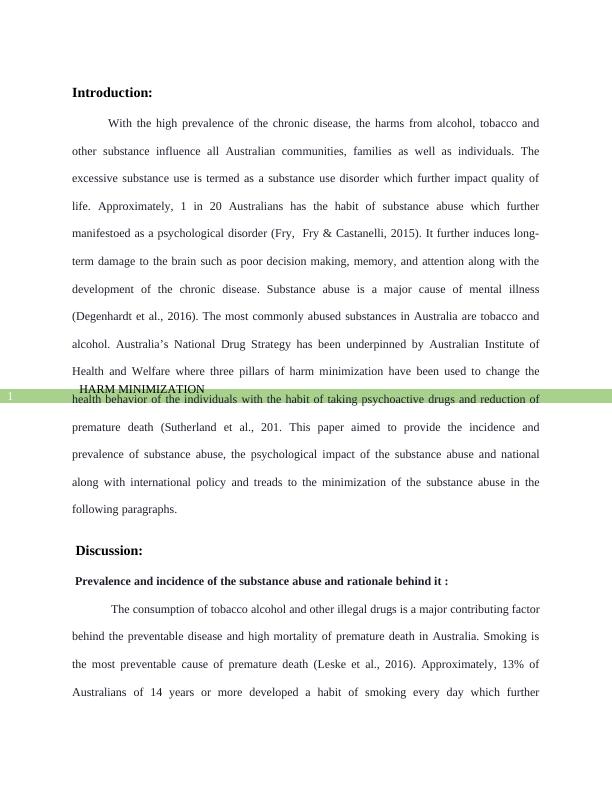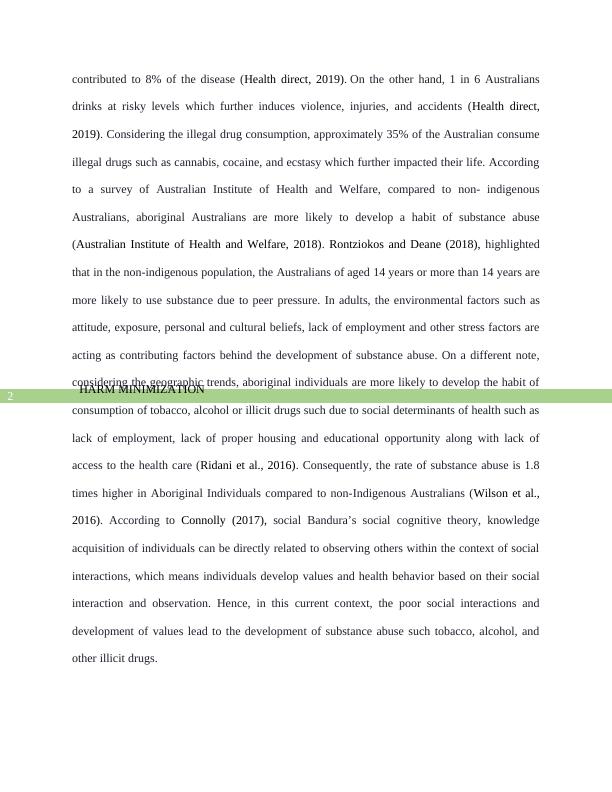Harm Minimization: Substance Abuse in Australia
Added on 2022-11-28
12 Pages2943 Words244 Views
Running head: HARM MINIMIZATION
HARM MINIMIZATION
Name of the student:
Name of the university:
Author note
HARM MINIMIZATION
Name of the student:
Name of the university:
Author note

HARM MINIMIZATION
1
Introduction:
With the high prevalence of the chronic disease, the harms from alcohol, tobacco and
other substance influence all Australian communities, families as well as individuals. The
excessive substance use is termed as a substance use disorder which further impact quality of
life. Approximately, 1 in 20 Australians has the habit of substance abuse which further
manifestoed as a psychological disorder (Fry, Fry & Castanelli, 2015). It further induces long-
term damage to the brain such as poor decision making, memory, and attention along with the
development of the chronic disease. Substance abuse is a major cause of mental illness
(Degenhardt et al., 2016). The most commonly abused substances in Australia are tobacco and
alcohol. Australia’s National Drug Strategy has been underpinned by Australian Institute of
Health and Welfare where three pillars of harm minimization have been used to change the
health behavior of the individuals with the habit of taking psychoactive drugs and reduction of
premature death (Sutherland et al., 201. This paper aimed to provide the incidence and
prevalence of substance abuse, the psychological impact of the substance abuse and national
along with international policy and treads to the minimization of the substance abuse in the
following paragraphs.
Discussion:
Prevalence and incidence of the substance abuse and rationale behind it :
The consumption of tobacco alcohol and other illegal drugs is a major contributing factor
behind the preventable disease and high mortality of premature death in Australia. Smoking is
the most preventable cause of premature death (Leske et al., 2016). Approximately, 13% of
Australians of 14 years or more developed a habit of smoking every day which further
1
Introduction:
With the high prevalence of the chronic disease, the harms from alcohol, tobacco and
other substance influence all Australian communities, families as well as individuals. The
excessive substance use is termed as a substance use disorder which further impact quality of
life. Approximately, 1 in 20 Australians has the habit of substance abuse which further
manifestoed as a psychological disorder (Fry, Fry & Castanelli, 2015). It further induces long-
term damage to the brain such as poor decision making, memory, and attention along with the
development of the chronic disease. Substance abuse is a major cause of mental illness
(Degenhardt et al., 2016). The most commonly abused substances in Australia are tobacco and
alcohol. Australia’s National Drug Strategy has been underpinned by Australian Institute of
Health and Welfare where three pillars of harm minimization have been used to change the
health behavior of the individuals with the habit of taking psychoactive drugs and reduction of
premature death (Sutherland et al., 201. This paper aimed to provide the incidence and
prevalence of substance abuse, the psychological impact of the substance abuse and national
along with international policy and treads to the minimization of the substance abuse in the
following paragraphs.
Discussion:
Prevalence and incidence of the substance abuse and rationale behind it :
The consumption of tobacco alcohol and other illegal drugs is a major contributing factor
behind the preventable disease and high mortality of premature death in Australia. Smoking is
the most preventable cause of premature death (Leske et al., 2016). Approximately, 13% of
Australians of 14 years or more developed a habit of smoking every day which further

HARM MINIMIZATION
2
contributed to 8% of the disease (Health direct, 2019). On the other hand, 1 in 6 Australians
drinks at risky levels which further induces violence, injuries, and accidents (Health direct,
2019). Considering the illegal drug consumption, approximately 35% of the Australian consume
illegal drugs such as cannabis, cocaine, and ecstasy which further impacted their life. According
to a survey of Australian Institute of Health and Welfare, compared to non- indigenous
Australians, aboriginal Australians are more likely to develop a habit of substance abuse
(Australian Institute of Health and Welfare, 2018). Rontziokos and Deane (2018), highlighted
that in the non-indigenous population, the Australians of aged 14 years or more than 14 years are
more likely to use substance due to peer pressure. In adults, the environmental factors such as
attitude, exposure, personal and cultural beliefs, lack of employment and other stress factors are
acting as contributing factors behind the development of substance abuse. On a different note,
considering the geographic trends, aboriginal individuals are more likely to develop the habit of
consumption of tobacco, alcohol or illicit drugs such due to social determinants of health such as
lack of employment, lack of proper housing and educational opportunity along with lack of
access to the health care (Ridani et al., 2016). Consequently, the rate of substance abuse is 1.8
times higher in Aboriginal Individuals compared to non-Indigenous Australians (Wilson et al.,
2016). According to Connolly (2017), social Bandura’s social cognitive theory, knowledge
acquisition of individuals can be directly related to observing others within the context of social
interactions, which means individuals develop values and health behavior based on their social
interaction and observation. Hence, in this current context, the poor social interactions and
development of values lead to the development of substance abuse such tobacco, alcohol, and
other illicit drugs.
2
contributed to 8% of the disease (Health direct, 2019). On the other hand, 1 in 6 Australians
drinks at risky levels which further induces violence, injuries, and accidents (Health direct,
2019). Considering the illegal drug consumption, approximately 35% of the Australian consume
illegal drugs such as cannabis, cocaine, and ecstasy which further impacted their life. According
to a survey of Australian Institute of Health and Welfare, compared to non- indigenous
Australians, aboriginal Australians are more likely to develop a habit of substance abuse
(Australian Institute of Health and Welfare, 2018). Rontziokos and Deane (2018), highlighted
that in the non-indigenous population, the Australians of aged 14 years or more than 14 years are
more likely to use substance due to peer pressure. In adults, the environmental factors such as
attitude, exposure, personal and cultural beliefs, lack of employment and other stress factors are
acting as contributing factors behind the development of substance abuse. On a different note,
considering the geographic trends, aboriginal individuals are more likely to develop the habit of
consumption of tobacco, alcohol or illicit drugs such due to social determinants of health such as
lack of employment, lack of proper housing and educational opportunity along with lack of
access to the health care (Ridani et al., 2016). Consequently, the rate of substance abuse is 1.8
times higher in Aboriginal Individuals compared to non-Indigenous Australians (Wilson et al.,
2016). According to Connolly (2017), social Bandura’s social cognitive theory, knowledge
acquisition of individuals can be directly related to observing others within the context of social
interactions, which means individuals develop values and health behavior based on their social
interaction and observation. Hence, in this current context, the poor social interactions and
development of values lead to the development of substance abuse such tobacco, alcohol, and
other illicit drugs.

HARM MINIMIZATION
3
Impact of substance abuse in population:
According to stress vulnerability model, human always carries genetic as well as other
predispositions of mental illness, which further highlighted that due to personal experience and
biological factors, some individuals are generally more vulnerable to the psychological disorders
compared to others. Eventually, when individuals experience stressors, they tend to use alcohol
and smoking which trigger or facilitate psychological distress inpatient. Connolly (2017),
highlighted that, individuals with a habit of substance abuse, tend to exhibit poor health behavior
and social harm such as violence, aggression, and anger. The use of alcohol or other illicit
increases the risk of depression and anxiety and other mental illnesses in some people.
Individuals with mental illness tend to experience substance-induced psychosis such as auditory
hallucination or delusions. Individuals with mental illness are more likely to develop the habit of
consuming tobacco and alcohol which further increase these symptoms (Gasior, Bond &
Malamut, 2016). Hence, substance abuse and mood disorders are interconnected. Alcohol
reduces the impact of antidepressants in the patient with mental illness such as depression and
anxiety. Consequently, alcohol and other consumption facilitate health harm such as suicidal
behavior, road trauma, lack of empathy, chronic disease development and violence in individuals
which further impacted the lives of individuals, families, and communities (Bei, B., Wiley, Allen
& Trinder, 2015). The economic harm, in this case, includes decreased productivity, increased
criminal activity, and increased health care cost.
Harm minimization as the strategy to reduce adverse impact:
Australian Institute of Health and Welfare (2018), designed a national framework for building
safe, healthy and resilient Australian communities through preventing as well as minimizing
alcohol, tobacco, and other drug-related health, social and economic harms among individuals,
3
Impact of substance abuse in population:
According to stress vulnerability model, human always carries genetic as well as other
predispositions of mental illness, which further highlighted that due to personal experience and
biological factors, some individuals are generally more vulnerable to the psychological disorders
compared to others. Eventually, when individuals experience stressors, they tend to use alcohol
and smoking which trigger or facilitate psychological distress inpatient. Connolly (2017),
highlighted that, individuals with a habit of substance abuse, tend to exhibit poor health behavior
and social harm such as violence, aggression, and anger. The use of alcohol or other illicit
increases the risk of depression and anxiety and other mental illnesses in some people.
Individuals with mental illness tend to experience substance-induced psychosis such as auditory
hallucination or delusions. Individuals with mental illness are more likely to develop the habit of
consuming tobacco and alcohol which further increase these symptoms (Gasior, Bond &
Malamut, 2016). Hence, substance abuse and mood disorders are interconnected. Alcohol
reduces the impact of antidepressants in the patient with mental illness such as depression and
anxiety. Consequently, alcohol and other consumption facilitate health harm such as suicidal
behavior, road trauma, lack of empathy, chronic disease development and violence in individuals
which further impacted the lives of individuals, families, and communities (Bei, B., Wiley, Allen
& Trinder, 2015). The economic harm, in this case, includes decreased productivity, increased
criminal activity, and increased health care cost.
Harm minimization as the strategy to reduce adverse impact:
Australian Institute of Health and Welfare (2018), designed a national framework for building
safe, healthy and resilient Australian communities through preventing as well as minimizing
alcohol, tobacco, and other drug-related health, social and economic harms among individuals,

End of preview
Want to access all the pages? Upload your documents or become a member.
Related Documents
Nursing 2022 Research Paperlg...
|7
|1678
|28
Addressing SDH in Health Policy Rationalelg...
|20
|5221
|71
Reform in Australian Mental Health Systemlg...
|6
|1083
|1
Cannabis Abuse Among Adolescents and Young Adults in Australialg...
|7
|1673
|216
INDIGENOUS SUBSTANCE ABUSE PROGRAM 2 INDIGENOUS SUBSTACNE USE PROGRAM Aboriginal and/or Torres Strait Islander Alcohol Use Prevention Programlg...
|16
|4879
|416
Substance Abuse disorders in the Aboriginal - PDFlg...
|16
|4757
|73
